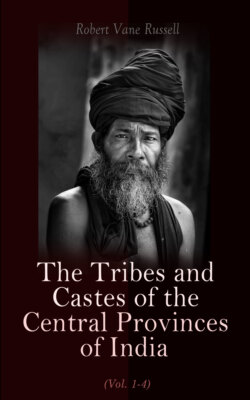Читать книгу The Tribes and Castes of the Central Provinces of India (Vol. 1-4) - Robert Vane Russell - Страница 9
Dādupanthi Sect.1
ОглавлениеDādupanthi Sect.—One of the sects founded by Vaishnava reformers of the school of Kabīr; a few of its members are found in the western Districts of the Central Provinces. Dādu was a Pinjāra or cotton-cleaner by caste. He was born at Ahmadabād in the sixteenth century, and died at Nārāyana in the Jaipur State shortly after A.D. 1600. He is said to have been the fifth successor in spiritual inspiration from Kabīr, or the sixth from Rāmānand. Dādu preached the unity of God and protested against the animistic abuses which had grown up in Hinduism. “To this day,” writes Mr. Coldstream, “the Dādupanthis use the words Sat Rām, the True God, as a current phrase expressive of their creed. Dādu forbade the worship of idols, and did not build temples; now temples are built by his followers, who say they worship in them the Dādubani or Sacred Book.” This is what has been done by other sects such as the Sikhs and Dhāmis, whose founders eschewed the veneration of idols; but their uneducated followers could not dispense with some visible symbol for their adoration, and hence the sacred script has been enthroned in a temple. The worship of the Dādupanthis, Professor Wilson says, is addressed to Rāma, but it is restricted to the Japa or repetition of his name, and the Rāma intended is the deity negatively described in the Vedanta theology. The chief place of worship of the sect is Nārāyana, where Dādu died. A small building on a hill marks the place of his disappearance, and his bed and the sacred books are kept there as objects of veneration.
Like other sects, the Dādupanthis are divided into celibate or priestly and lay or householder branches. But they have also a third offshoot, consisting in the Nāga Gosains of Jaipur, nearly naked ascetics, who constituted a valuable part of the troops of Jaipur and other States. It is said that the Nāgas always formed the van of the army of Jaipur. The sect have white caps with four corners and a flap hanging down at the back, which each follower has to make for himself. To prevent the destruction of animal life entailed by cremation, the tenets of the sect enjoin that corpses should be laid in the forests to be devoured by birds and beasts. This rule, however, is not observed, and their dead are burnt at early dawn.
1 This article is compiled from the notices in Wilson’s Hindu Sects, As. Res. vol. xvi. pp. 79–81; Sir E. Maclagan’s Punjab Census Report, 1891; and Mr. Bhimbhai Kirpārām’s Hindus of Gujarāt, Bombay Gazetteer, vol. ix.
